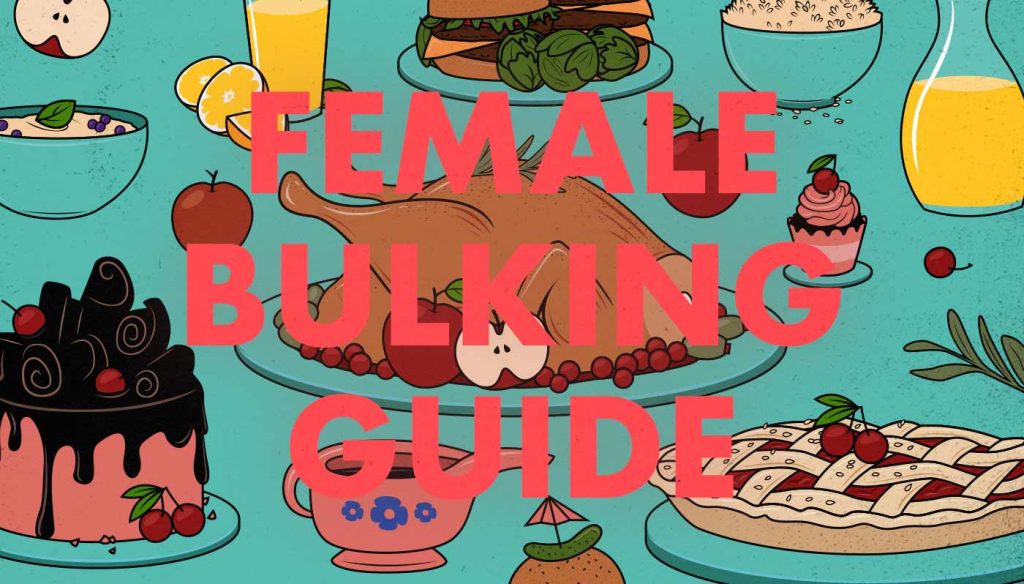
The Bulking Diet Guide for Women
This bulking diet guide will teach you the basics of eating for muscle growth. This is how the top athletes and fitness models build muscle. It’s also what modern science shows us is most effective. This isn’t just theory, either. Over the past decade, we’ve used these exact dietary principles to help over 3,000 naturally thin women build muscle quickly and leanly.
I’ve personally used these methods to gain over 60 pounds. Cassandra used them to gain twenty. As a strength coach, Marco has given these same recommendations to the professional athletes he’s trained—including members of our women’s Olympic rugby team.
There are three parts to this guide:
- How much you should eat to gain weight. (And how to adjust.)
- What proportion of protein, carbs, and fat you should eat.
- What actual foods you should eat.
There’s nothing edgy or controversial here. We won’t claim that this is the one and only way to eat for muscle growth. These are indeed the most effective methods, having been refined by both research and tradition over several decades, but you can modify most of them—if you know how. We’ll teach you how.
The Conventional Bulking Diet
When a revolutionary new diet is proposed, it can appear to have limitless potential. It could be a way to get better results than anyone ever has before. It’s thrilling to think that we’ve found the solution. But almost all of these new methods eventually wind up proving to be at least slightly less effective than a more time-tested and traditional bulking diet.
There are a few reasons for this.
- This bulking diet is based on research that has been conducted over several decades, with each new study building upon the overall body of evidence, with small tweaks being made here and there.
- This bulking diet is rooted in the bodybuilding tradition, with the most effective methods being those that have stood the test of time. Also, keep in mind most muscle-size (hypertrophy) researchers aren’t just dorks in lab coats—they’re also fans of building muscle. They’re dorks, yes, but muscular ones.
- This diet is nearly identical to what athletes eat, giving us another tradition and line of research to draw from. After all, most athletes, including female ones, benefit from being stronger and more muscular.
Now, is it possible someone has come up with a brand new way to improve on these bulking methods? Of course! This diet isn’t a static thing. It’s been improved and refined many times over the years. All of those improvements were brand new at some point. The thing is, they tend to be incremental improvements. A small tweak results in an improvement that’s barely noticeable. But when enough of those small improvements are combined together, the overall approach grows much stronger.
When these improvements have proven themselves in the field and the lab, they get incorporated into this conventional bulking diet. Have we missed some points? Certainly. But they’re probably unimportant, and it’s wiser to wait until there’s more evidence to support anything we’ve left out. As the research currently stands, this is the best bulking diet for women.
A Calorie Surplus For Women
How Quickly Should Women Gain Weight While Bulking?
The most important part of any bulking diet is the calorie surplus. That’s the heart of bulking. That’s what bulking is. That’s what allows women to gain weight, build curves, and build muscle at full speed.
But how big should that calorie surplus be for women? And how fast should women gain weight?
As a rule of thumb, gaining around 0.5–1 pound per week allows us to build muscle fairly fast while keeping our gains quite lean (systematic review).
We can do a bit better than that, too. The researchers say skinny beginners can gain muscle faster, gaining as much as 1–2 pounds per week without showing much fat gain. We often see the same thing when helping our members bulk up:
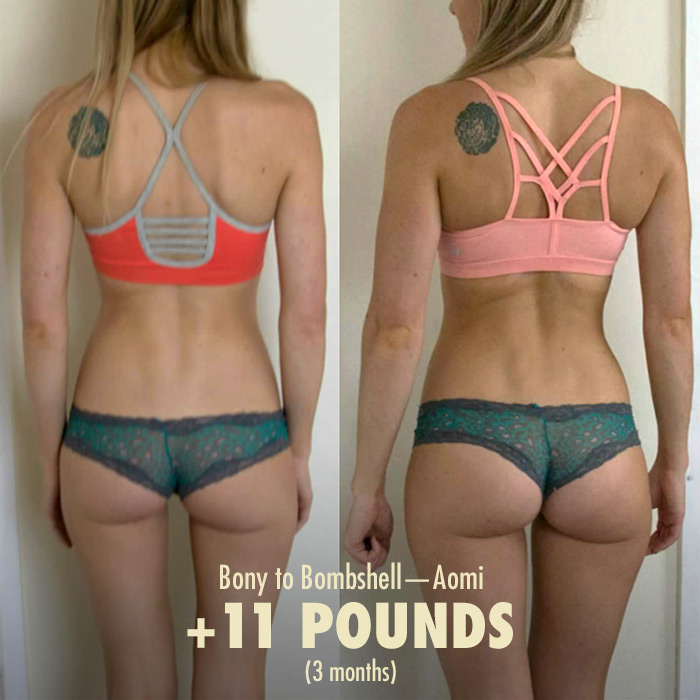
Then, as that woman builds more muscle, she’ll get closer to her genetic potential, and her rate of muscle growth slows. So for intermediate female lifters who have already gained their first 10 pounds, a better rule of thumb is to gain 0.25–0.5 pounds per week.
To be clear, some research shows you can get even faster muscle growth with faster rates of weight gain, even in advanced bodybuilders. But that extra muscle growth often comes at the cost of gaining a disproportionate amount of body fat (study). This is known as the muscle-to-fat ratio.
In most cases, the extra speed in muscle gain isn’t worth it—especially for women. Plus, for every study showing a benefit to gaining weight faster, there’s another study showing that both men and women will get super fat by rushing things. We want the best of both worlds: fast muscle growth with minimal fat gain.
Gaining as many as 2 pounds per week can work well for very skinny women who are just starting to bulk up. But with such an abundant intake of calories, the risk of fat gain is also great. For most women, gaining more like 0.25–0.5 pounds per week (a total of 1-2 pounds per month) is a good default for women to aim for while bulking.
How To Get Into A Calorie Surplus For Women
There are three main ways you can get into a calorie surplus:
- Calorie counting: using your body weight and activity levels, you can loosely estimate how many calories it will take for you to gain weight. For example, you could take your body weight in pounds and multiply it by 18–22. That’s a good range for most skinny girls who are eager to bulk up. For someone who weighs 120 pounds, that’s 2,150–2,650 calories per day. For a better shot at leaner gains, use the lower side of that range. To err on the side of faster muscle growth, use the higher side. Calorie counting works best for meticulous people who love tracking and min-maxing their life. I’ve done it. It worked.
- Adding calories: it takes roughly 250 extra calories per day to gain half a pound per week. Therefore, you can gear into bulking by adding 250 calories to the diet that you normally eat. This works well for women who eat similar meals every day as part of their routine, giving them a stable base to build upon. The trick is to make sure you keep up with your regular meals even as the awful sense of fullness pervades your life. This is how I bulk now, as a dad who lives on a schedule. I prefer it to tracking calories. But for women who like to have a lot of variety in what they eat, and therefore a bigger variety of daily calorie intake, it may not be the best fit.
- Eating 10–15% more: if you don’t want to think about calories at all, you can simply think about eating more. If you increase the size of your meals by 10–15%, that will get you into a reasonable calorie surplus. Again, this works best if your diet is fairly consistent from day to day. This is how most women who are into lifting as a hobby do it. Bulking is an excuse to eat more. However, skinny girls often struggle with this method.
Choose whichever method you prefer, and don’t worry too much about being perfectly precise. It’s common for beginners to get hung up here, trying to calculate exactly how many calories they’ll burn. The truth is, no calculation, no matter how complex, is accurate enough to be all that useful in terms of accuracy. This is just a starting point. You must tweak based on your follow-up weigh-ins. The sooner you start, the sooner you can refine what you’re doing.
How to Adjust Your Calorie Intake For Women
A common beginner mistake is to fail to gain weight, assume your initial calorie estimates are off, and then go back to the drawing board, redoing those initial calculations. That’s the wrong approach. If you aren’t gaining weight, you aren’t eating enough calories. Add more calories to your diet plan. It’s that simple.
Whatever method you choose, the most important thing is to adjust your daily calorie intake based on how much weight you gain each week.
- If you’re not gaining weight, add 100–200 calories.
- If you’re gaining weight too fast, remove 100–200 calories.
For example, if you weigh 120 pounds and start by eating 2,400 calories per day, perhaps your Hellish metabolism is not so easily overcome, and you find yourself failing to gain weight. That isn’t a flaw of the formula, it doesn’t mean you’re doomed to stay skinny forever, and it doesn’t mean you need to retreat back to calorie formulas. March onwards, and add more calories.
There’s a bit of nuance here, though. Our weight fluctuates quite a lot throughout the day. (And even throughout the month due to hormones!) If you weigh yourself before breakfast, you might be a few pounds lighter than you are after dinner. So there are a few tricks to tracking your weight gain:
- The first week is a wildcard. Hold steady. When you first start bulking, you’re adding extra food into your digestive system, you’re inflating your muscles full of glycogen, and you’re adjusting to a new intake of salt in your system. As a result, it’s common to see the scale bump up by 2–3 pounds. And that’s great. There’s no need to eat fewer calories if that happens. Just ride it out for another week.
- Always weigh yourself at the same time of day, controlling for as many variables as possible. For example, weigh yourself every Sunday morning after peeing and before having anything to eat or drink. Even better if your dinner the night before is fairly consistent from week to week. (Or, for even more precision, you can weigh yourself every morning and compare your average weight every Sunday.) We recommend that our members buy their own digital weight scale so they can weigh themselves at the same time of the day.
- If you’re somewhat close to the ideal pace, you’re good. If you’re aiming to gain half a pound each week, but you gain 0.3 or 0.8 pounds instead, that’s sweet. Those small discrepancies are well within the realm of natural fluctuations. You don’t need to adjust by 100 calories or anything. Just hold steady. You’re doing great.
- There will come a time when your weight gain will slow. As you get stronger, curvier, and more muscular, you’ll burn more calories. Maybe you can gain 5 or even 10 pounds without needing to adjust your calorie targets. But eventually, you’ll need to add more calories to your bulking diet to continue gaining weight. (Gaining 10 pounds of muscle burns roughly 60 extra calories. But when you’re deep into a bulk, your body will spend calories frivolously. You may notice your metabolism growing ever faster.)
Bulking Macros For Women
What are Macronutrients?
The food we eat contains nutrients. Some nutrients, such as vitamins and minerals, don’t contain energy. These are called micronutrients. Other nutrients, namely protein, carbs, fat, and alcohol, do contain energy. These are called macronutrients—otherwise known as macros.
For the purposes of building muscle, we care about three macros:
- Protein contains 4 calories per gram, breaks down into amino acids, and is used to build muscle (among other things, like hair, skin, and nails). This is why protein is often considered the most important macronutrient for building muscle. Don’t underestimate the others, though.
- Carbs contain 4 calories per gram, break down into glucose (a simple sugar), and are stored in our muscles as a fuel called glycogen (among other things). Carbs aren’t a necessary part of our diets, but they’re a great energy source, help with stress, often come packaged along with fibre for gut health, make our muscles fuller and stronger, and increase our rate of muscle growth.
- Fat contains 9 calories per gram, breaks down into fatty acids, and is stored as body fat, which can be slowly burned for energy (among other things). Fat is also important for regulating hormones and is a source of several fat-soluble vitamins, making it a vital part of our diets. These fat-soluble vitamins aren’t just needed to live but needed to thrive.
You don’t need to know any deep science about the macros, but it does help to know what we use them for. The ones we’re most interested in for building muscle are protein (building blocks) and carbs (energy), but that doesn’t mean fat isn’t important.
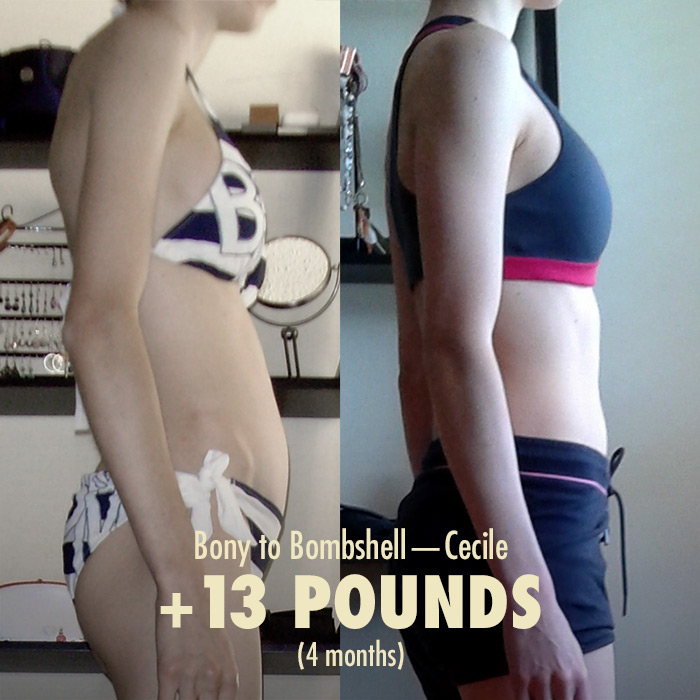
How Much Protein Should A Woman Eat While Bulking?
When trying to build muscle, a good rule of thumb is to aim for roughly 1 gram of protein per pound of body weight per day. So if you weigh 120 pounds, eat around 120 grams of protein daily. Nutrition labels tend to make this easy, listing how much protein there is in each serving. Otherwise, you can weigh your food on a food scale and look up how much protein it contains.

One gram/pound/day is a rough goal, though. The latest research shows eating as little as 0.7 grams of protein per pound bodyweight per day works just as well (2019 systematic review). Similarly, Jose Antonio, Ph.D., has been doing research for years showing extremely high-protein diets are neither better nor worse for building muscle than moderate-protein diets (study, study, study).
Consuming 5.5 times the recommended daily allowance of protein has no effect on body composition in resistance-trained individuals.
Jose Antonio, PhD
What seems more important is spreading your protein intake out over the day. If you can eat 3–6 meals per day, all containing at least 20 grams of protein, then you should be able to build muscle faster and more leanly (2019 systematic review).
As a result, intermittent fasting isn’t recommended while bulking. Intermittent fasting can also wreak havoc on the moods of some women. If you prefer intermittent fasting, it can indeed work, but a more even protein distribution tends to be even better for muscle gain. Plus, intermittent fasting reduces our appetite, making it harder to eat enough calories to gain weight. That’s not a problem for everyone, but it’s often a problem for naturally skinny people (like us). Plus, if you try and eat less often, that means bigger meals, which could cause acid reflux or other digestive problems.
The next question is what types of protein to eat. Fortunately, it doesn’t seem to matter. We can get our protein from:
- seafood
- poultry
- red meat
- dairy
- eggs
But as we explain in our article on vegan proteins, plant-based sources of protein are solid as well. Nuts, legumes, grains, seeds, peas, and soy all contain some protein, too. The real trick is to make sure you’re getting enough protein.
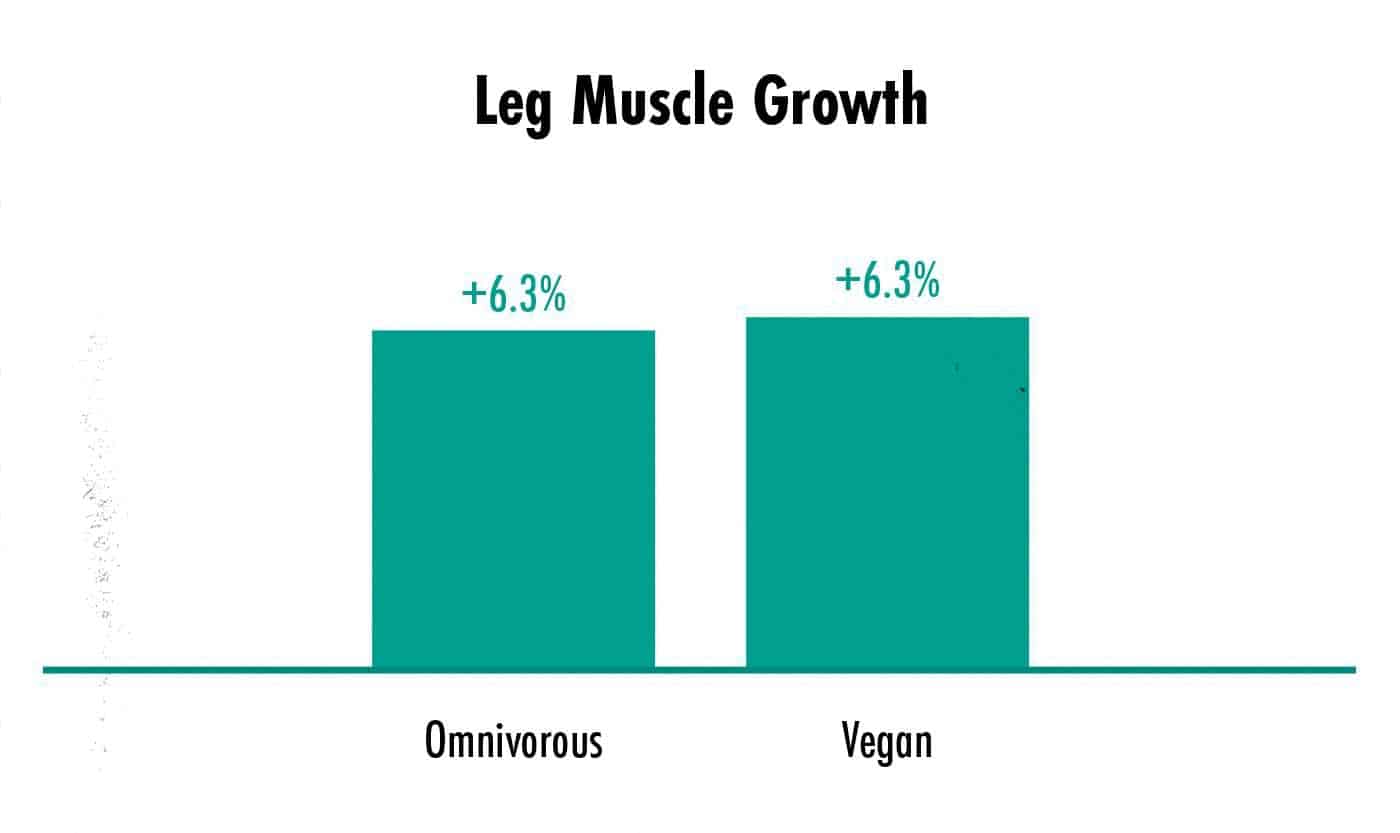
Vegan and omnivorous diets build muscle equally well (2021 Hevia-Larraín study).
So to summarize, a good default for women is to aim for 1 gram of protein per pound bodyweight per day, to spread it out over 3+ meals, and to make sure each meal contains at least 20–30 grams. For instance, maybe you have 3 eggs with breakfast, some nuts as a midmorning snack, a bowl of lentil stew for lunch, some chicken or steak with dinner, and a little cottage cheese or Greek yogurt before bed.
How Much Fat Should A Woman Eat While Bulking?
Dietary fat isn’t that important for building muscle. Not that you shouldn’t eat any, just that you’re probably eating enough already. When you get into a bulking diet, you probably won’t need to intentionally add any extra.
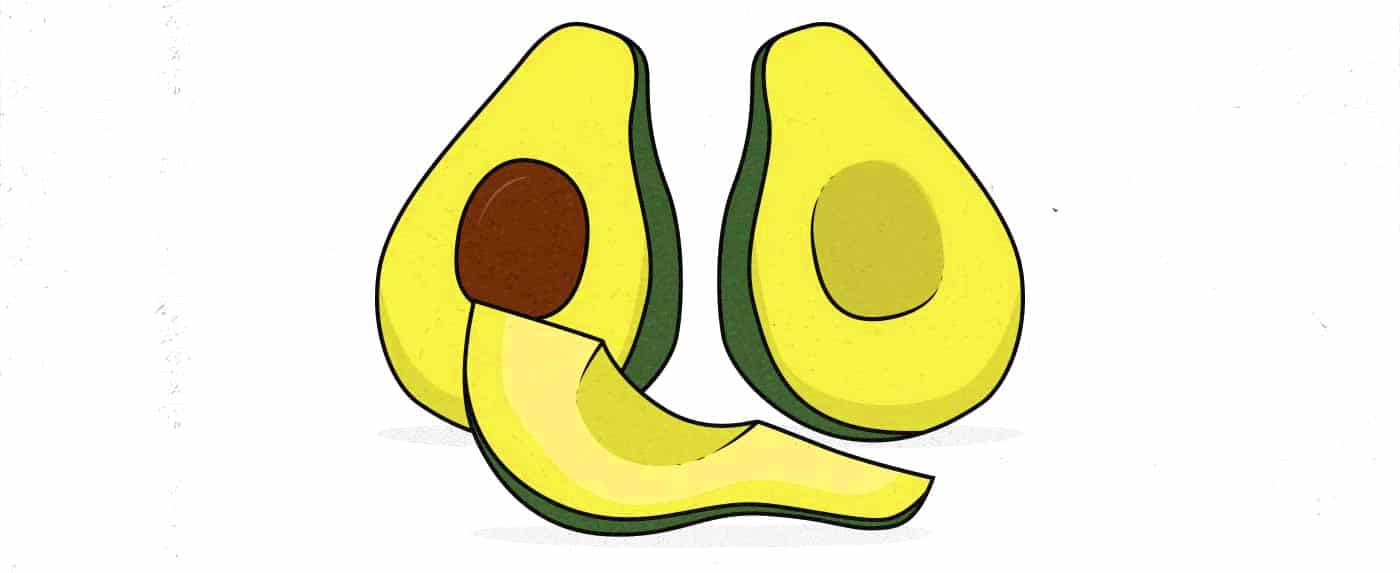
When bulking, you want something like 0.25–0.75 grams of fat per pound body weight per day, which usually works out to around 15–30% of your total calories. If you aren’t tracking your macros, that’s okay. There’s no need for great precision here.
The thing to keep in mind is how dense fat is calorically. It contains over twice as many calories per gram as protein and carbs. It’s common for women to start tracking their calories only to realize they’re getting 50%+ of their calories from fat. That’s not the end of the world, but if you want to make the fastest and leanest muscle gains possible, it’s probably better to get the bulk of your surplus calories from carbs instead.
As for where to get your fat, try to choose unprocessed foods. Try to get a mix of saturated, monounsaturated, and polyunsaturated fats. Think about fats like extra-virgin olive oil, avocados, fatty seafood (such as salmon), eggs, kefir, yogurt, etc.
So to summarize, most women already eat enough fat. When you start eating a bulking diet, you’ll probably eat even more fat naturally. You probably don’t need to add any extra intentionally. If you’re adding 250 calories into your diet at the start of your bulk, you’ll probably want most of those extra calories coming from carbs and protein.
How Many Carbs Should A Woman Eat While Bulking?
Carbs have become controversial. Perhaps they’re simply too good at helping women gain weight, and so are being blamed for the obesity epidemic. But as skinny people, this is not our issue. In fact, ours is the opposite: we tend to have a hard time gaining weight.

Indeed, when researchers remove carbs from people’s diets, they often have a hard time gaining weight and muscle. For people who are overweight, that’s great. For skinny women trying to bulk up, though, limiting carbs only makes their quest all the harder.
For instance, if we look at a 2021 paper by Paoli and colleagues, we see restricting carbohydrates can cut our rate of muscle growth in four:
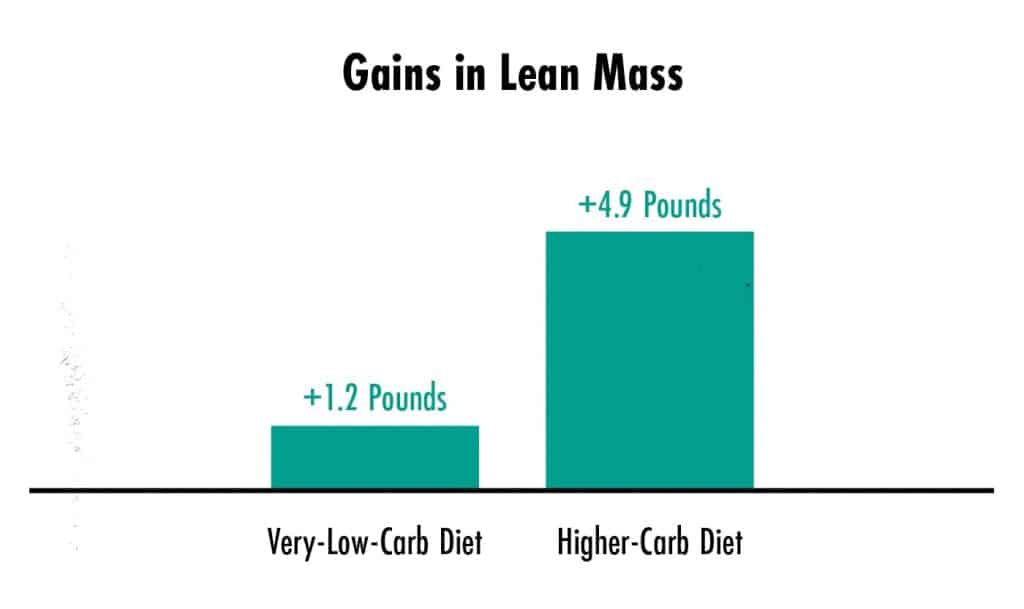
There’s some nuance to this study, as we explain in our article on ketogenic diets on our brother site. The low-carb group had a harder time eating enough calories to gain weight, thrashing their ability to build muscle. Plus, limiting their carb intake caused them to store less glycogen in their muscles, reducing their muscular endurance and making them appear less muscular. That may have hidden the muscle they gained.
This is all to say that if we look at the research, it’s clear carbs are a valuable ally for women who are trying to add curves through muscle (study). That’s why conventional bodybuilding diets, bulking diets, and athletic diets recommend getting around half of their calories from carbs:
- For gaining muscle mass, research shows getting 40–60% of our calories from carbohydrates improves our workout performance, gives our muscles a fuller appearance, and increases our rate of muscle growth (study, study).
- For gaining general strength, The National Strength & Conditioning Association recommends getting 45–65% of our calories from carbohydrates. They note that this range is best for our general health, for building muscle, and for gaining strength.
- For improving athletic performance, The Journal of the International Society of Sports Nutrition recommends eating enough protein to maximize muscle recovery and growth, enough fat for good hormonal health, and then getting the rest of our calories from carbohydrates. That typically works out to around 40–60% of our calories coming from carbs.
Now, it’s worth pointing out that these recommendations include wide ranges, and that this is a fairly minor factor to begin with. If you get a third of your calories from carbs instead of half, you probably won’t notice the difference. As a result, there’s no need to track your carb intake. Eating plenty of carbs is great, but there’s no dire need to be precise.
When bulking, getting 40–60% of your calories from carbs is ideal. But this is a rough target with a wide range. Tracking your carb macros isn’t required. Eating fewer carbs is fine if that agrees with your body the most.
What Foods Should Women Eat While Bulking
The Supposed Magic of Muscle Chili
I built most of my muscle out of habanero chili. Every Sunday, I’d cook up a giant pot, put a few servings in the fridge, and put a few more servings in the freezer. Whenever I wanted a convenient bulking meal that was also healthy and delicious, all I had to do was reheat it in the microwave and toss a bit of pre-ground cheese or cilantro on top. I am a lazy efficient person, and so as a single man, this often meant I was eating chili at least twice per day. (When we got married, Cassandra quickly cured me of this “problem.”)

Now, it might sound like I’m trying to sell you on a chili diet. I’m not. Our Bony to Bombshell Bulking Program includes a full recipe book, and you’ll see my chili recipe featured proudly in all of its deserved glory. But the truth is, it’s just a convenient meal that happens to be a good source of protein and carbs. The chili is predominantly made from lean ground meat, which is high in protein, and beans, which is a great source of fibre and carbs (along with some extra protein). Chili is magic, but so are many other meals.

Whatever is available where you live, whatever you can afford, whatever you like—that’s what you should build your bulking diet out of. Here are some examples of great meals to eat while bulking:
- Chili
- Picadillo
- Paella
- Stir fry
- Sushi
- Vindaloo curry
- Salmon and potatoes
- Beef and potato stew
- Chicken, rice, and broccoli
- Vegan lentil stew
These are all perfect bulking dinners. You can eat whichever you prefer, cycle through all of them, or eat something totally different. The same goes for breakfast, lunch, and snacks. One person might blend up a fruit smoothie with a protein powder, another person might prefer oatmeal, and a third might prefer eggs. All of those are great options. All are made mostly out of whole foods, all contain enough protein, and all will build the same amount of muscle.
So what I’d encourage you to do is think about meals made out of mostly whole foods, that you love, that you can passionately bulk up with. Bulking means eating a lot of food. It’s way better if you love that food.
The Power of Whole Foods For Women Who Are Bulking
There’s a war raging on in the muscle-building world. It’s a war that’s lasted for several decades. One side fights for “clean” eating, the other for If It Fits Your Macros (IIFYM). And that’s just the influencers and fitness models. If you look at how athletes eat, you’ll see a variety of other diets, ranging from keto to paleo to carnivore to “see-food” diets (where you eat everything you see).

Most of these diets have an advantage or two, but the best way to get the benefits of all of them without any of the needless restrictions or potential downsides is simply to focus on eating whole foods.
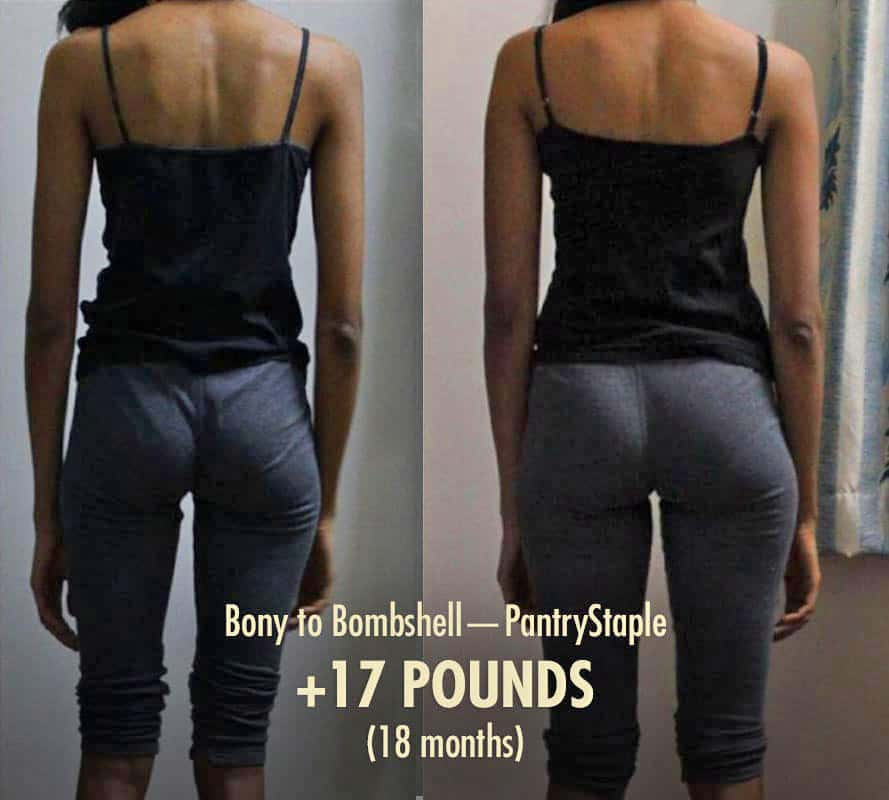
A good rule of thumb is to get around 80% of your calories from whole foods, with 20% of your calories coming from whatever.
In practice, that usually means eating a good breakfast but letting yourself have some sugar in your coffee and some butter on your sourdough toast (if you want). Then eating a good lunch but not worrying about how many calories are in the sauces you like. Then finishing the day with a good dinner but having some dessert afterwards if you’ve still got calories to power through. And if you want to eat at a restaurant a few times per week, no problem, just order the dishes that include a hearty source of protein.
A good bulking diet is built on a foundation of whole foods, but that doesn’t mean you can’t include some regular indulgences. It’s okay to have a margarita after a long day. It’s okay to eat white rice instead of brown rice (for bulking white rice is superior). Don’t sweat the details, but do get the foundation right.
The Case for Simple Carbs When Bulking
When planning a bulking diet for the very first time, a lot of women try to get all of their carbs from “healthy” sources, such as veggies, whole grains, legumes, and oats. Don’t get me wrong, those are all fantastic foods. But when eaten in large quantities, they can be difficult to digest, often causing stomach pain, bloating, and bulking miasmas.
There’s a reason that bodybuilders are famous for eating large servings of white rice: it’s easier to digest! Plus, there’s no real downside. Simple starches are perfectly good for building muscle quickly and leanly. The trick is to add that white rice into a diet that includes other sources of fibre, vitamins, and minerals.
That’s why the classic bodybuilder meal is chicken, broccoli, and rice. The chicken and broccoli are rich in protein, micronutrients, and fibre (especially if you drizzle some extra virgin olive oil on that broccoli). And then the white rice adds in a ton of easily digested-carbs.
So what you want is balance. Include some whole grains, legumes, and veggies in your diet, but when you’re struggling to add more carbs, consider adding simple carbs: white rice, starchier fruit like bananas, fruits in general, fruit juice—that kind of thing. This is especially important if you’re eating carbs before your workout. You’ll want to eat something easier to digest so your stomach doesn’t bother you while working out.
The Place for Supplements As A Woman Who’s Bulking
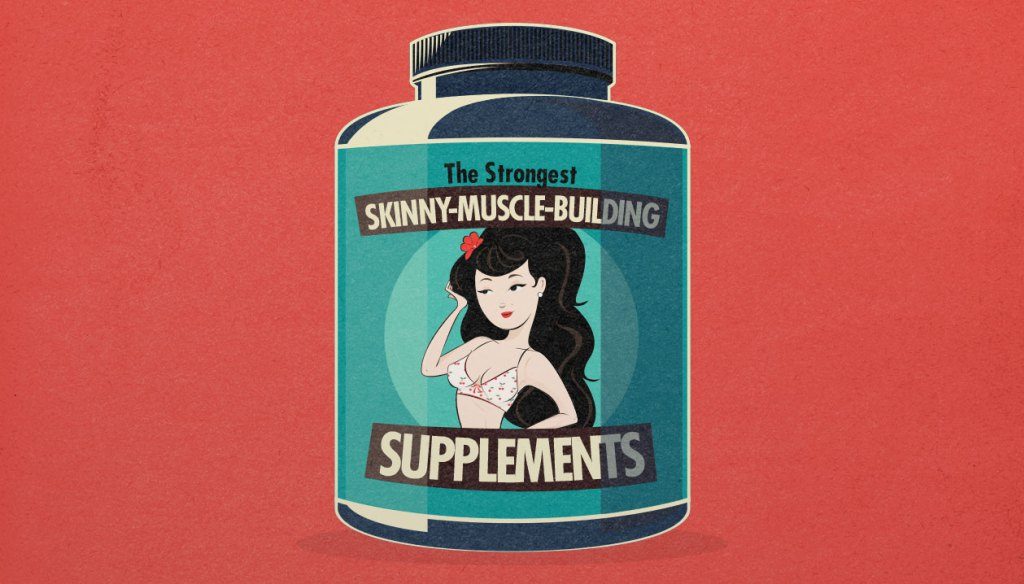
You don’t need to take any supplements while bulking, and their benefits are often exaggerated. Pre-workout supplements are ubiquitous among lifters, even female lifters, despite the fact they offer little more benefit than a simple cup of black coffee. Still, there are a few supplements that can indeed come in handy.
- Protein powders are an easy source of protein. That’s really all there is to it. It isn’t better or worse than other sources of protein, just more convenient. Whey protein isolate makes for the best default, but plant-based options are equally great, especially if you don’t do well with dairy products.
- Creatine is one of the only supplements that’s proven to increase the rate of muscle growth. It’s cheap, healthy, effective, and has been thoroughly tested for many decades (systematic review).
- Caffeine is the most powerful ergogenic (which means performance-enhancing) supplement. If you take enough of it before working out (often 300+ mg), you’ll be able to do more reps more easily. The problem is that if you’re lifting weights at the end of the day (some members lift after their kids are in bed), that might be too much too close to your bedtime. So, instead of taking massive amounts of caffeine for the ergogenic effects, we usually have a cup of coffee more for the psychological effects—a bit of extra motivation and a bit of reward for lifting.
Great Bulking Foods For Women
Okay, so we’ve covered a bunch of dietary principles and given some examples. But what foods should you be eating to bulk with as a woman? What are some examples to get your salivary juices flowing?
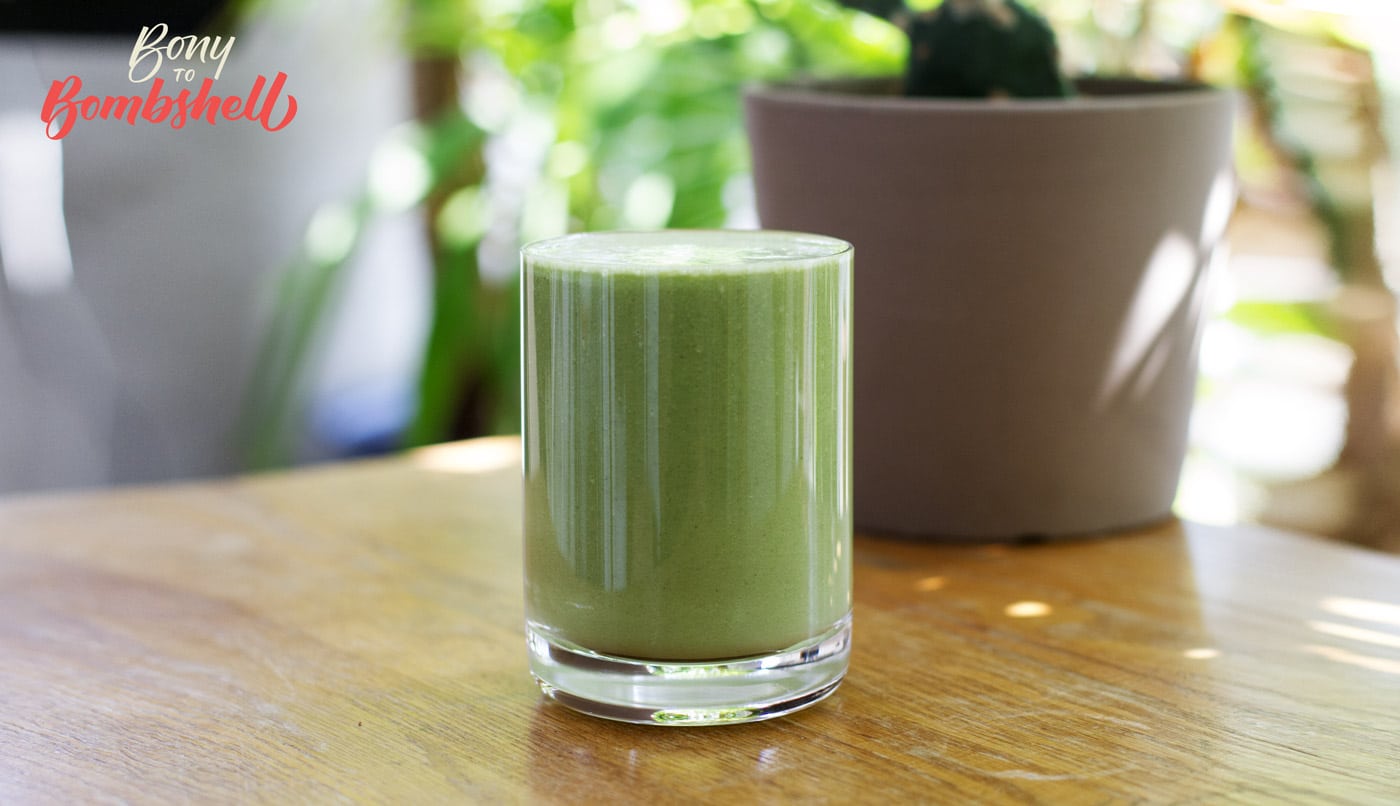
When bulking, the main challenge for most naturally skinny women is eating enough calories to gain weight. To make bulking easier, we want to lean into foods that are nutritious, energy-dense, and easy to digest. Here’s a list of examples to get you started:
- Smoothies are the Queen of bulking drinks. Blend up some frozen berries, a banana, spinach, yogurt, oats, and a scoop of protein powder and you’ve got yourself a 100% ideal bulking meal that’s healthy and delicious. Best of all, you can prepare and drink it in under 5 minutes. And because it’s been blended, it will pass through your digestive system quickly.
- Trail mix is the Queen of bulking foods. There are many different styles, but my favourite is a simple mix of nuts and dried fruits (such as cranberries, raisins, peanuts, and almonds). Most styles of trail mix contain more than 500 calories per cup, meaning that by adding a single cup of trail mix to your diet, you can shift into a nice bulking surplus.
- Milk is easy to prepare, breezy to consume, and quick to digest, and it’s loaded with calories balanced from protein, carbs, and fat. A cup of whole milk contains 150 calories, meaning if you add a cup of milk to three meals each day, you’re adding 450 calories to your diet. That’s a great calorie surplus to start with. Fermented dairy, like kefir, may be best for those with a sensitive digestive system.
- Muesli cereal is made up of nuts, grains, and dried fruit combined with milk. These are exactly the sorts of foods and nutrients we need while bulking. If you like the idea of eating cereal, this is often the best way to do it.
- Extra Virgin Olive Oil is a nutritious source of fat. Like all oils, its energy density is off the charts. Drizzling a tablespoon of olive oil on your roasted veggies will add 119 calories to your meal.
- Nuts (and nut butters) are another great source of easy calories. For example, if you spread two tablespoons of natural peanut butter onto a slice of bread, you’re adding 200 calories to it. Aside from being cheap, this explains why peanut-butter-and-banana sandwiches are so popular among young athletes trying to gain muscle.
- Dried fruits pack the same nutritional punch as regular fruits, but because they contain so much less water, they’re much smaller, taking up much less space in your mouth and stomach. Dried mangoes, dried bananas, raisins—the options are endless, and it tastes like candy.
- Dark chocolate is a nice treat that’s actually pretty healthy because it’s rich in many vitamins and minerals, including magnesium, iron, and copper. It can be a great snack while bulking.
- Protein shakes. One of the hardest things about bulking is getting enough protein, especially when you aren’t used to including a protein source with every meal. Protein shakes make that very easy.
- Weight gainers are somewhat controversial—especially for women. They’re made by combining simple carbs (such as maltodextrin) with protein powder (such as whey protein). They’re quick to prepare, the macros are perfect, and they are fairly easy to digest. Just keep in mind maltodextrin is a “junk” food, so make sure to get plenty of whole foods elsewhere in your diet.
- Bananas are nature’s carb pill. They are a large pill, yes, and you’ll probably want to chew it, but it’s hard to find a more convenient source of healthy and easily digested carbohydrates.
- White rice is a simple starch, a fantastic source of easily digested calories. With a rice cooker, it’s a breeze to prepare, and many people find it easy to eat in large quantities, either on its own or as a base for curries, stir-fries, and chilis. Rice was one of Marco’s staple foods while gaining over 70 pounds, and is a staple for many of our Bombshell members.
- Oats were initially more famous for helping horses bulk up, but have since become quite popular with humans as well. They aren’t quite as easy to digest as white rice, but they contain more fibre and micronutrients.
- Cheese.
- Yoghurt is rich in probiotics, which can help to improve our digestive power. Some types of yogurt, such as Greek yogurt, are also incredibly high in protein.
- Kefir made from milk is another great source of probiotics, making it easier to digest, and is also quite high in protein. Unlike yogurt, it’s often consumed as a drink, making it easier to eat.
- Eggs are nature’s muscle-building multivitamin, containing quite a lot of protein, good fats, and many vitamins and minerals.
- Ground meat is like regular meat, except it’s easier to chew and quicker to digest, making it great for bulking up. What’s neat is it tends to feature more tendons and connective tissues than cushier cuts of meat, making it arguably more nutritious.
- Salmon (and other fatty fish) are packed full of protein and are an excellent source of omega-3 fatty acids (ALA, EPA and DHA), which are an important part of a healthy diet. Because of this extra fat, salmon is much higher in calories than other fish.
- Spinach, Beets, and Leafy Greens are rich in dietary nitrate, which is proven to improve our blood flow and workout performance (study). An easy way to include more nitrate in your diet is to blend some spinach into a fruit, yogurt, and protein smoothie. If that’s hard on your digestive system, you can cook them. Add some healthy fats, and you’ve got a powerhouse of nutrition with tons of calories.
Summary
To summarize there are just a few things to keep in mind:
- You need to eat enough calories to gain weight. Gaining 0.25–0.5 pounds per week is a good default for a female beginner or early intermediate lifter who’s eager to bulk up, but any amount of weight gain, no matter how gradual, will have you seeing progress over time. To do this, you need around 250 extra calories per day. But remember that if you aren’t gaining weight, you need to add more calories to your diet! We usually recommend adding 100-200 calories whenever you stop gaining weight for more than two weeks in a row.
- You need to eat enough protein to build muscle. Eating 1 gram of protein per pound bodyweight per day is a good default, but anything over 0.7 grams of protein per pound bodyweight per day will be enough for women to build muscle at full speed. (And eating tons of extra protein doesn’t seem to offer any additional advantages, at least when it comes to muscle.)
- Carbs are good. You can build muscle without eating any carbs, but the more carbs you eat, the easier it will be. There’s no need to track your carb intake, but getting around 50% of your calories from carbs tends to be ideal for building muscle, improving your workout performance, and keeping your muscles looking full and hard. Eating easy-to-digest carbs like white rice and fruit is a no-brainer.
- Eat real food, but otherwise, go with your preferences. The best way to build muscle quickly, leanly, and healthfully is to eat a diet made up mostly of whole-ish foods. These “whole-ish” foods include minimally processed foods like yogurt, white rice, raw honey, whey protein, whole-grain bread, and so on. Since you’ll also be eating a lot of food, perfection isn’t required, and you should have no problem getting the nutrients and fibre you need. A good default is to aim for at least 80% minimally processed whole foods (meat, fruits, veggies, dairy (particularly fermented dairy), whey, rice, etc) and no more than 20% junk food (sugary sauces, pastries, Cheerios, weight gainers, piña coladas, margaritas, daiquiris, mezcal, etc).
- Eat balanced meals and spread them out. The ideal bulking diet is made up of 3–6 meals spread out evenly over the course of the day, with each of those meals containing at least 20–30 grams of protein. That way you’ll be building new curves all day long, spiking a bit of muscle protein synthesis with each and every meal.
If you can follow these diet principles, rest assured that your diet will never hold back your muscle growth. The other major factors to look into are your workout program (the #1 most important thing) and getting enough good sleep each night.
Alright, now you know enough to get started. Good luck!
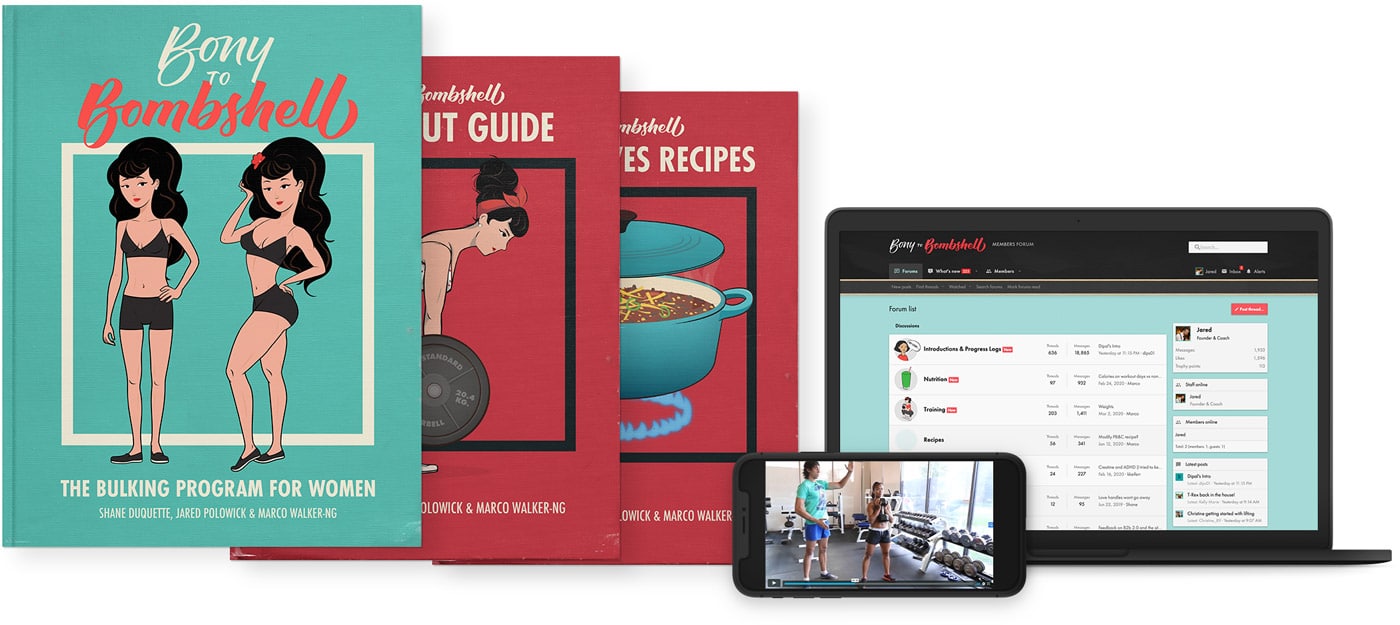
If you want a full bulking program, including a 5-month workout routine, diet guide, recipe book, and coaching, check out our Bony to Bombshell bulking program for women. If you liked this article, you’ll love our full program.



FREE women's Muscle Growth MINI-COURSE
Get our 5-part female bulking mini-course that covers everything you need to know about:
Here are some related articles